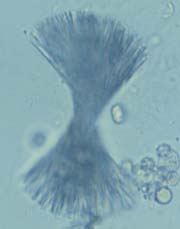The presence of iatrogenic crystals is a rare event. Except for the Indinavir crystal, a light crystalluria due to a medication or from a contrast agent for X-ray imagery has no clinical significance. On the other hand, an abundant crystalluria associated with a hematuria, a marked cellularity, and oliguria could indicate an obstructive renal disease. The presence of casts with crystalline inclusions clearly indicates that the crystallization is intratubular.
The majority of these drugs crystallize in an acid media often around a pH of 5,0. Drugs of the sulfamides group (sulfamethoxazole, acetylsulfadiazine, sulfadiazine) are the most frequently observed.
| Name | Characteristics | General aspect | Comments |
| Acetylsulfadiazine, sulfadiazine | Yellow brown crystals of variable
shape
Asymetric rosette Birefringent |
 |
Not to be confused with urates and
uric acid. Rarely used today. |
| Sulfamethoxazole (Septra, Bactrim) |
Brown spheres thin plates and rosette |
 |
Seen in overdosage |
| Ampicilline | Fine needles, uncolored | Rare, seen only at very high dose | |
| Contrast agent Renografin Hypaque |
Uncolored plates Strongly birefringent Mimics cholesterol |
 |
Seen in pale specimen with a density >1,040 |
Indinavir
Indinavir, a protease inhibitor (antiviral agent) widely used, to treat patients with HIV infection, has been associated with nephrolithiasis. Indinavir is insoluble at physiological pH so that, 20% of the person receiving Indinavir have characteristic crystal in their urine. The crystal are seen as plate-like rectangles exibiting rosette formation
The crystal are birefringent under polarized light with a color dispersion as seen with uric acid. Indinavir crystal, unlike uric acid, are seen at a neutral (6,5 7,5) while uric acid crystals are seen at a more acidic pH (5,0 - 5,5)

